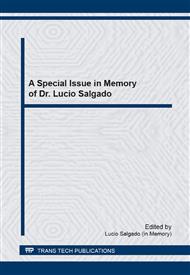p.106
p.111
p.116
p.122
p.128
p.137
p.143
p.149
p.155
Direct Manufacture of Hydroxyapatite Scaffolds Using Blue Laser
Abstract:
The study deals with the direct manufacturing of hydroxyapatite scaffolds using selective polymerization of the slurry liquid phase. The bovine hydroxyapatite has great similarity with the human bone structure, making it able for a direct connection with the bone tissues. This study aims to obtain scaffolds using a new technique of rapid prototyping, obtained by polymerization of acrylic resin (liquid phase of slurry) by ultraviolet light present in a range of the band spectrum emitted by the blue laser light. Sub-micrometer hydroxyapatite was obtained by the calcination and grinding of bovine bone in a vibratory mill. Mixtures of hydroxyapatite and resin were prototyped in three-dimensional pieces and sintered afterword and subjected to blue laser emission path directed in a CNC equipment. Grounded particles obtained in the grinding vibratory mill, with equivalent diameter of 0.35 microns, were reactive enough to compensate the low green densification bellow 50 vol%. Polymerization tests realized indicated that the incidence of the laser with fluency of 170 mW.s/mm2 promoted the curing of the 0.5 mm diameter pieces in depth about 0.5 mm, which allowed the prototyping of the scaffolds with sufficient mechanical strength for handling.
Info:
Periodical:
Pages:
128-133
Citation:
Online since:
September 2014
Keywords:
Price:
Сopyright:
© 2015 Trans Tech Publications Ltd. All Rights Reserved
Share:
Citation:


